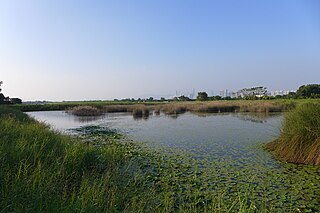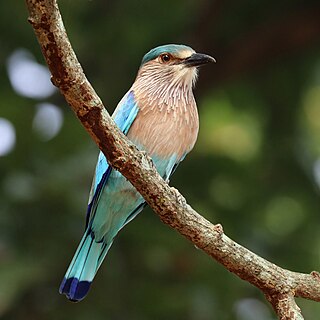Related Research Articles

The Thar Desert, also known as the Great Indian Desert, is an arid region in the north-western part of the Indian subcontinent that covers an area of 200,000 km2 (77,000 sq mi) in India and Pakistan. It is the world's 18th-largest desert, and the world's 9th-largest hot subtropical desert.

The fishing cat is a medium-sized wild cat of South and Southeast Asia. Since 2016, it is listed as Vulnerable on the IUCN Red List. Fishing cat populations are threatened by destruction of wetlands and have declined severely over the last decade. The fishing cat lives foremost in the vicinity of wetlands, along rivers, streams, oxbow lakes, in swamps, and mangroves.

Mai Po Marshes (Chinese: 米埔濕地; Hong Kong Hakka: Mi3bu4 Sip5ti4) is a nature reserve located in San Tin near Yuen Long in Hong Kong. it is within Yuen Long District.

The Indian roller is a bird of the family Coraciidae. It is 30–34 cm (12–13 in) long with a wingspan of 65–74 cm (26–29 in) and weighs 166–176 g (5.9–6.2 oz). The face and throat are pinkish, the head and back are brown, with blue on the rump and contrasting light and dark blue on the wings and tail. The bright blue markings on the wing are prominent in flight. The sexes are similar in appearance. Two subspecies are recognised.

An aquatic ecosystem is an ecosystem found in and around a body of water, in contrast to land-based terrestrial ecosystems. Aquatic ecosystems contain communities of organisms—aquatic life—that are dependent on each other and on their environment. The two main types of aquatic ecosystems are marine ecosystems and freshwater ecosystems. Freshwater ecosystems may be lentic ; lotic ; and wetlands.

Delhi Ridge, sometimes simply called The Ridge, is a ridge in the Northern Aravalli leopard wildlife corridor in the National Capital Territory of Delhi in India. It is a northern extension of the ancient Aravalli Range, some 1.5 billion years old. The ridge consists of quartzite rocks and extends from the southeast at Tughlaqabad, near the Bhatti mines, branching out in places and tapering off in the north near Wazirabad on the west bank of the river Yamuna, covering about 35 kilometres.

Narowal is a city located on the western bank of river Ravi in the northeast of the province Punjab in Pakistan. The city is the capital of district Narowal, and a part of the Gujranwala division. It is the 94th largest city of Pakistan. The economy is largely agriculture-based but Football production and handicrafts industries also exist. Narowal houses many universities campuses, including the University of Narowal, University of Engineering and Technology Narowal Campus and the University of Veterinary and Animal Sciences Narowal Campus. The fertile land of Narowal produces one of the supreme quality rice in Pakistan.

The state of Karnataka in South India has a rich diversity of flora and fauna. It has a recorded forest area of 38,720 km2 which constitutes 22% of the geographical area of the state. These forests support 25% of the elephant population and 20% of the tiger population of India. Many regions of Karnataka are still unexplored and new species of flora and fauna are still found. The mountains of the Western Ghats in the western region of Karnataka are a biodiversity hotspot. Two sub-clusters of the Western Ghats, Talacauvery and Kudremukh, are on a tentative list of sites that could be designated as World Heritage Sites by UNESCO. The Bandipur and Nagarahole national parks which fall outside these subclusters were included in the Nilgiri biosphere reserve in 1986, a UNESCO designation. In the Biligiriranga Hills the Eastern Ghats meet the Western Ghats. The state bird and state animal of Karnataka are Indian roller and the Indian elephant. The state tree and state flower are sandalwood and lotus. Karnataka is home to 524 tigers.

Serendip Sanctuary is a 250 ha protected area in Victoria, Australia, near the You Yangs and the town of Lara, some 22 km north of Geelong and 60 km south-west of Melbourne. Originally used for farming and other purposes, it was purchased in 1959 by the State Government of Victoria for wildlife research and the captive management and breeding of species threatened in Victoria, such as the brolga, magpie goose, Australian bustard, and bush stone-curlew. The sanctuary contains many different types of wetland and is home to many plant species as well, such as river red gums, tall spikerush, and tussock grass. Serendip now focuses more on environmental education about the flora and fauna of the wetlands and open grassy woodlands of the Volcanic Western Plains of Victoria. It was opened to the public in 1991 and is now managed by Parks Victoria.

Sahowala is a town in Sambrial Tehsil, Sialkot District, Punjab, Pakistan. It is located between the Upper Chenab Canal and the Marala Ravi Link Canal of the Marala Headworks project. Demographically, the town has a Union Council which is one of the largest councils in Sialkot, having a population around 20,000 which covers six neighbouring villages. Many residents are farmers, while others work abroad and serve in the industry and government. There is a big center of Tehreek Labaik Pakistan. The town is close to the Sialkot Tanneries Zone. Minhaj ul Quran Islamic Library is the public library, along Noor Mosque, which has the highest minaret in the Sialkot District. First Market and shopping center constructed at main Sahowala Road near Noor Mosque named DEEN CENTER since 2021. This village has a history of more than 800 years. Mughal Colony was also established in Sahowala.
Kotli Loharan is a small town in Sialkot District, Pakistan. K. L industry by Muhammad Younas used to manufacture mine-laying machines, hydraulic jacks and instruments for F-86 aircraft engine maintenance for the Pakistan Army. A rural hospital funds were raised, a veterinary hospital, boys and girls colleges, schools and roads have been constructed. Bazaars have been widened in 2010, Fresh water filtration plants have been installed in various locations. New Building of veterinary Hospital constructed, Streets are cemented, Rural Hospital new building constructed and upgraded, Ring roads are made.

The wildlife of Pakistan comprises a diverse flora and fauna in a wide range of habitats from sea level to high elevation areas in the mountains, including 195 mammal, 668 bird species and more than 5000 species of Invertebrates. This diverse composition of the country's fauna is associated with its location in the transitional zone between two major zoogeographical regions, the Palearctic, and the Oriental. The northern regions of Pakistan, which include Khyber Pakhtunkhwa and Gilgit Baltistan include portions of two biodiversity hotspot, Mountains of Central Asia and Himalayas.

Harike Wetland also known as "Hari-ke-Pattan", with the Harike Lake in the deeper part of it, is the largest wetland in northern India in the border of Tarn Taran Sahib district and Ferozepur district of the Punjab state in India.

The Rann of Kutch is a large area of salt marshes that span the border between India and Pakistan. It is located mostly in the Kutch district of the Indian state of Gujarat, with a minor portion extending into the Sindh province of Pakistan. It is divided into the Great Rann and Little Rann.

Ramsagar National Park is a national park in Bangladesh located at. 25°33'00"N 88°37'30"E Tejpur, near Dinajpur District in the north-west of the country. The Park is 27.76 hectare, in size, and is built around a large water reservoir known as "Ramsagar tank". The lake is 1079m in length and 192.6m in width. The soil is red-yellow clay
Blue Bird Lake, Hisar is a resident and endangered migratory bird wetland habitat, lake and recreation area in the town of Hisar, in the Hisar district of Haryana State, India.
Gadgor is a small Town in Pasrur Tehsil, Sialkot District, Pakistan. Towns near Gadgor include Behrampur, Jahar, Joshan, Chobara, chak meer da,Gillan Wala, Chawinda, Kotli Mughlan and Philoura. Its geographical coordinates are 32° 24' 0" North, 74° 46' 0" East. Gadgor is in the centre of the Chawinda and Kingrah sectors.

Bajwat is an area of the Sialkot district and Narowal district of Punjab province in Pakistan. It comprises 84 villages, with a population of 110,000 according to 2018 Servery.

Haiderpur wetland is a UNESCO Ramsar site located near the Bijnor Ganga Barrage within the Hastinapur Wildlife Sanctuary in Uttar Pradesh, India.
References
- ↑ Bhinder, M.A. (2015). "AVIAN BIODIVERSITY OF BAJWAT WETLAND, DISTRICT SIALKOT. PAKISTAN" (PDF). The Journal of Animal and Plant Sciences. 25 (3 Suppl. 2): 416–422. Retrieved 24 March 2016.
- ↑ Bhinder, Muhammad Ahmed (September 1, 2015). "Avian biodiversity of Bajwat wetland, district Sialkot. Pakistan". Research Gate. The Journal of Animal and Plant Sciences. Retrieved November 11, 2023.
32°41′N74°33′E / 32.683°N 74.550°E